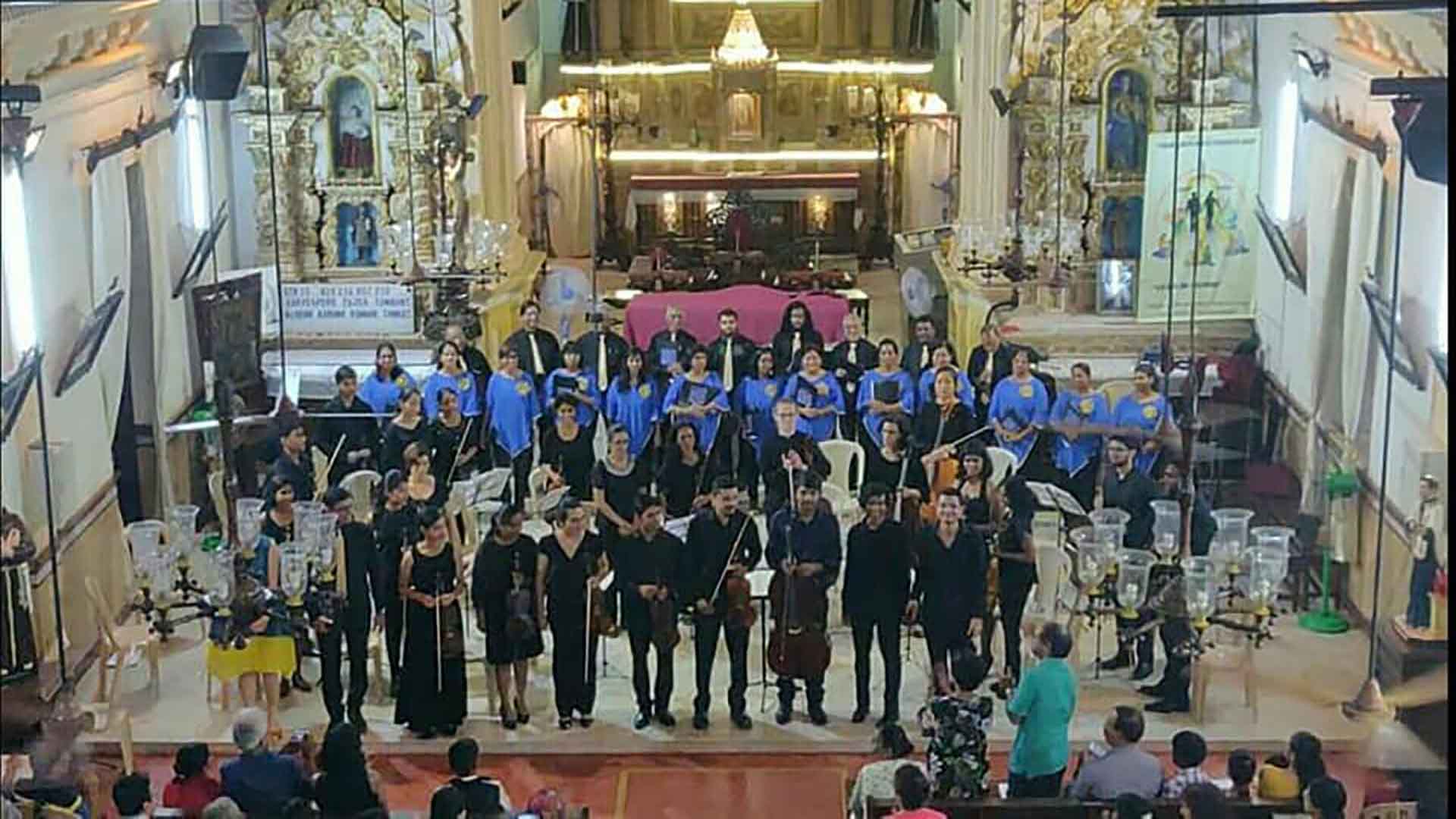Stuti and the Strings
This is a translation of a chat I had with Fr Eufemiano Miranda, founder of Goa String Orchestra and Stuti Chorale Ensemble, on my podcast Renascença Goa. Click here for the original chat in Portuguese.
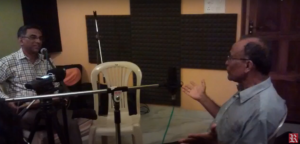
O.N. Father Miranda, to begin with, tell us something about how these two entities were born, and for what purposes!
E.M. Well, I first started the Goa String Orchestra… that was some time in 2003, when here in Goa we had a choir coming from King’s College, England. They presented a beautiful programme at the church of St Francis of Assisi… And then I thought to myself: we in Goa who always say we are the Italians of the East… we have nothing organized, be it a small orchestra, a small choir… None of that. It was worth having something.
At that time, there were some young people who had graduated in violin, viola, cello. And there were also teachers, among them Myra Shroff, who has taught almost a whole generation of students; and she would always say to me: ‘ah, can’t we have a little string orchestra?’ And I would say, ‘why not?’ So, with whatever we had, I started an orchestra.
Well, it’s not enough just to bring together the members of an orchestra; you have to have a dynamic person behind it, to give it life, to give it movement. And at that time, I started the Goa String Orchestra with Mr Nigel Dixon, who was then with the Kala Academy.
O.N. Very good. That was around 2003. And years later…?
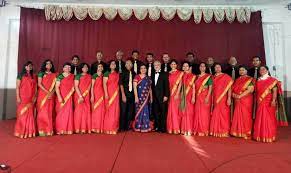
E.M. And later on, there were people who watched our shows and enjoyed what we performed; and there were people who wanted to sing – people with good voices – and with these people I started the Stuti Choral Ensemble, in 2009. It has always been my goal to keep the tradition of classical music alive in Goa…
O.N. Father, you are the driving force behind both these entities…
E.M. Well, I like to use a simpler word: I am a coordinator. My job is to say to these musicians: ‘Come here, let’s make music’; and with their collaboration, I do my work.
O.N. Father, you are much more than that… you have an important voice in both entities, both figuratively and literally speaking, because you also sing!
E.M. Ah, yes! I sing, I enjoy, I enjoy singing. I sing tenor.
O.N. And how many members does Stuti and Goa String Orchestra consist of?
E.M. At Goa Strings, I have a few who, I would say, are regular artists… these would be about 10. Every year there are students who graduate, and I keep calling them; and I like to form a string orchestra with some 18 members or so…
O.N. So, Stuti always has Goa Strings for musical backing…!
E.M. No, no; each entity works independently, but, as you know, in Goa it is difficult to organize concerts in two modalities, choral and instrumental; and so, I prefer to call the choir and orchestra to present a programme together.
O.N. And so far, you must have done at least twenty-five programmes, both inside and outside Goa…!
E.M. That’s it! When Stuti was formed, we immediately got a call from the Bangalore School of Music for a Christmas programme. And it was going to be our first opportunity to perform in public, outside of Goa. We got good reviews in the Bangalore papers. I would say this gave us new motivation.
Well, we always work within our means. For example, at the moment, I am working with a person, a good friend of mine, Antonio Calisto Vaz, and I have asked him to direct the Stuti Choral Ensemble. But I consider it a divine grace that I have conductor Parvesh Java with me.
Fostering Goan Musical Talent
O.N. In the general plan of both Stuti and the Strings Orchestra, what role does the Goan musical repertoire play?
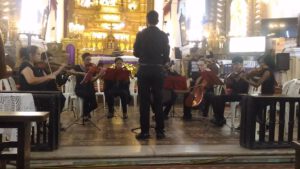
E.M. As I have always said, my ideal is to preserve Goan music. Evidently, we have music from the Christian community of Goa, both religious music and folk music. In my orchestra programme I always wanted to have Goan music played by the orchestra, and we had to present programmes: so, what would we present? My brother, Francisco Miranda, who is a priest and good musician, and I chose “Diptivont Sulakini”: it was so beautiful! I wrote an introduction; he wrote that for two flutes and strings, and accompanied by small Indian timpani (kansaddi), because, as you know, that is a typical Goan music. It’s a Western melody, I would say, but not entirely Western, but not an Eastern melody either, but it’s typically Goan, and one that can be perfectly performed to the Indian rhythm, let’s say. Then I could perfectly play it using the tabla and kansaddi. And we did that under the baton of Nauzer Daruwala. It was really beautiful…
O.N. Well, what adds value to your work, Father, is that you not only perform, but also take the trouble of working on arrangements and harmonies…
E.M. That’s it! We are a group, let’s say, that sings stylized music, in four voices. It is necessary to harmonize that to four voices. If an orchestra is going to play that, it needs to be harmonized for five strings, so the very fact that our group, both instrumental and choral, is a stylized, erudite group, we have to make this music, whether folk or religious, more stylized. After all, what was that music from Europe? Pablo de Sarasate, for example, wrote the Spanish dances: it’s music from Spain that he stylized. The same with Brahms who did the Hungarian dances; Dvorak wrote the Slavonic dances. My way of thinking is this: why can’t we do the same?
O.N. And how do you solve logistical problems?
E.M. I always say to my choir and orchestra members: look, we have to make music for music’s sake, art for art’s sake. Our rehearsal time is 6.30 p.m. to 8.00 p.m. I am very grateful to Kala Academy for giving us the facility to use the rehearsal room once a week…every Wednesday.
O.N. So, what plans for the near future?
E.M. I don’t have big plans. We want to continue to do the work that we are doing, that is, to value music from Goa and to have a group here that is a voice that represents Goa, and in the event of having to present a programme, we would be ready to present a small one, anywhere…
O.N. …like musical ambassadors of Goa!
E.M. We would like to be that!
Western Classical Music Scene in Goa
O.N. Father Miranda, how do you see the western classical music scene in Goa?
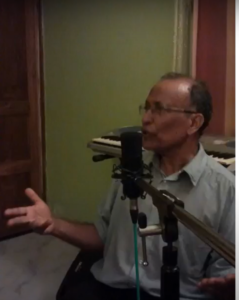
E.M. Well, first of all, I would say that to have a taste for Western classical music, you need to have a certain preparation, you need to have a certain musical education. In Goa, there are people who enjoy classical music. And it all depends on people, taste, education and promotion… it all depends on the family… I mean, I really like classical music, but why is that? Because when we were little – we are eight brothers and sisters – my father was very fond of classical music. It was at a time when there was nothing, nothing... when we were little children, there was only a gramophone... and then he would play, he liked to play that, and talk about that music... Well, there was music that we liked and some other that we didn’t like. But my father always instilled in us this taste for music… ‘That’s a beautiful Beethoven melody; that’s a beautiful Mozart melody’, he said… and he sang it himself. There is, therefore, the cultural climate of the family that contributes greatly to the promotion of classical music.
In the seminary, music was and still is a subject. You have to study music and pass in that subject, if not, one wouldn’t be ordained... My other brothers who went to high school at that time had a music academy there. There was choral singing there, in high school. Home and school: all this contributed to my brothers’ and my liking for classical music.
But the taste for classical music is not so widespread throughout Goa. We like to listen to it, but we don’t bother to appreciate it so much: that’s what’s lacking among us.
O.N. Father, you have been part of Kala Academy’s advisory board for a few years… What is left to be done before we seen an improvement in the level of teaching and musical culture?
E.M. Well, I would say that we need, first of all, a person with the highest musical academic training… A good musician has to know how to write the music, harmonize the music; a good musician must also know how to compose music and then he must also eventually know how to direct, and encourage others to sing and play. There are so many aspects. To do so, you have to have a degree at a higher institute of music…
Contribution of the Goa Church
O.N. Well, what is the Seminary’s contribution towards the promotion of sacred music and towards the development of the musical sense of the Goans?
E.M. Ah, I would say in my day it was western music all the way; and Gregorian music… All that was part of the curriculum. I don’t know how it is nowadays.
I had good teachers… I had a teacher called Father João Baptista Viegas: he was self-taught; he was a good musician and he himself learned to play the violin and teach music from Dominic Pereira. This was a great musical figure, a violinist from Porvorim; he was a family friend of Dominic Pereira’s. He learned from him, and he played the violin himself. It was a pleasure to see how Father João Baptista played the violin and taught the students.
Then, at Rachol Seminary, I had maestro Camilo Xavier: he had passed through Rome where he learned music and did a lot for the cause of music in Goa.
Now, the Seminary, where priests are trained in music, has contributed a lot. I would say, a musical culture was developed through the Goan clergy.
Well, the Church has always had the liturgy in mind... the priests and musical formation in function of the liturgy. Hence, in order to dynamize the masses artistically, the liturgical services, the liturgical acts, music was taught to the students and the priests.
Culture always starts with religion; religion a key to culture. This contributed a lot to, let’s say, a musical atmosphere that exists in Goa, through the priests. There are also lay people – so many lay people who have learned music and made their contribution. But then, that’s the role of the priests: each one in their respective parish builds the infrastructure of a parish choir. And the church choir is the group that gives musical support when the whole assembly sings.
O.N. But it’s not just the liturgy, it’s not just the parish; but in society, too, there are examples of how the church has contributed to Christianize certain local songs and dances…
E.M. Yes, it’s always so. In society there is always an interaction. There are the principles of the church… well, why can't you give it a very typical Goa look? For example, khell tiatr, which has music… it is always the music of the Christian community… let’s not forget that… so I would say religion has played an important and fundamental role in the formation of typical Goan music…
O.N. Exactly! And what are the initiatives of the modern church in Goa, towards dynamizing musical talent?
E.M. The Church of Goa has taken great care to see that the parts of the Mass, or liturgical acts, which include antiphons, and other musical things have musical backing. Hence, new melodies and arrangements are composed and new musical groups formed.
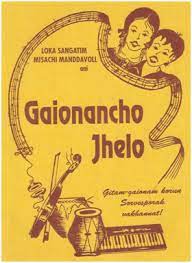 O.N. They say that our Gaionancho Jhelo is one of the best here in India…
O.N. They say that our Gaionancho Jhelo is one of the best here in India…
E.M. Yes, because Gaionancho Jhelo, above all, comprises many new lyrics and old lyrics, and everything is well tucked in a bouquet of very beautiful lyrics for use by the liturgy…
The Goan Motet
O.N. We cannot end without a word about the motet… Father, may I know what is the originality of the Goa motet!
E.M. First of all, the motets of Goa were composed in the same spirit in which the motets of Europe were composed. The motet of Europe was a song whereby people sang and at the same time reflected and ruminated on the biblical text relating to the respective feast. But in Goa the motets were limited to the Lenten season.
Now the Goa motets are not very difficult; they are beautiful and very well made. People who can read music can meet, and easily perform a motet. The musical accompaniment always includes violins, clarinets and the double bass…
O.N. In Europe, they were a capella…
E.M. Yes, but not all. For example, “Jesus, joy of man’s desiring”, by Bach, is a motet, as you know, from the feast of the Visitation of Our Lady…. The melody was simple. Bach’s contribution comprised the introduction that he wrote, and then he wrote an interlude and the final part, and that turned out into such a big piece. Therefore, it was a motet of the Visitation feast of Our Lady.
These motets of ours are just the same: a small musical motif, which has an accompaniment, and introduction of musical instruments; then they are sung, that is, repeated, then there is an interlude, and an ending. That’s it – the structure is very similar to that of the Western music motet, from the cathedrals of Europe.
O.N. Father, I’m afraid we’ve reached the end of our chat. Sorry to have to stop. But, before we close: you will certainly agree that the harvest is great, but the workers few…. What is your message to our people? What’s your plea?
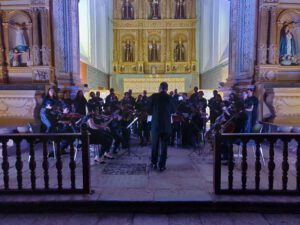
E.M. First of all, thank you very much for this opportunity to speak here in your studio…
My message would be as follows: we are very proud to be musicians. Let’s uphold this tradition; let’s work in order that our new generation, our next generation, learn from what we do.
Now, there are so many young people in our parishes, whether or not they have a musical education, let’s give them the opportunity to be part of the choir, go there and learn a musical instrument, and come with that instrument to the church, and eventually on to the platforms offered to them.
My Stuti Choral Ensemble as well as the Goa String Orchestra will always be a platform for those who want to sing, each according to their ability… Come, you are always welcome!
I would love parents to take this task of taking their children to schools and showing them good musical programmes in our cities or elsewhere, such that younger people gain a taste for that, and then we would have a new generation of people.
O.N. Thanks again, Father Eufemiano, and long live the Goa String Orchestra and the Stuti Choral Ensemble! Thank you very much!
E.M. Thank you!
First published in Revista da Casa de Goa - II Série - N15 - Março Abril de 2022
